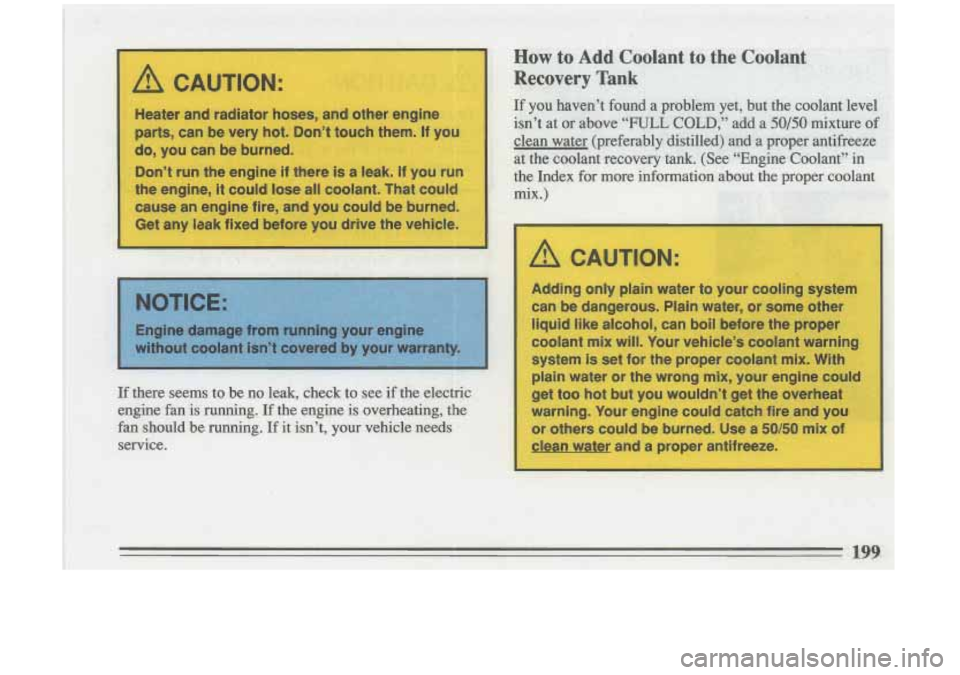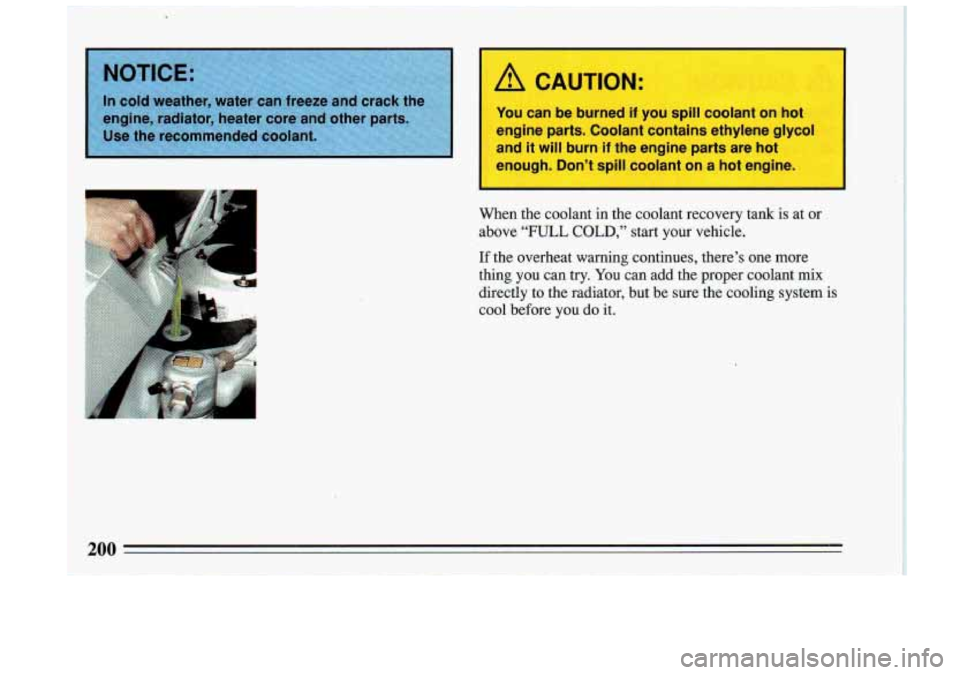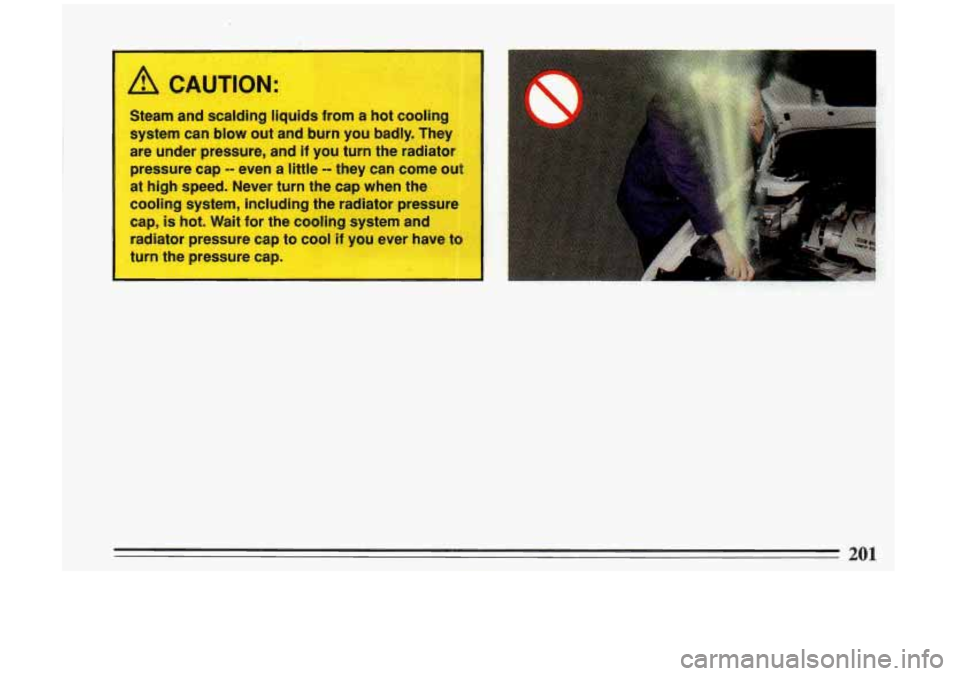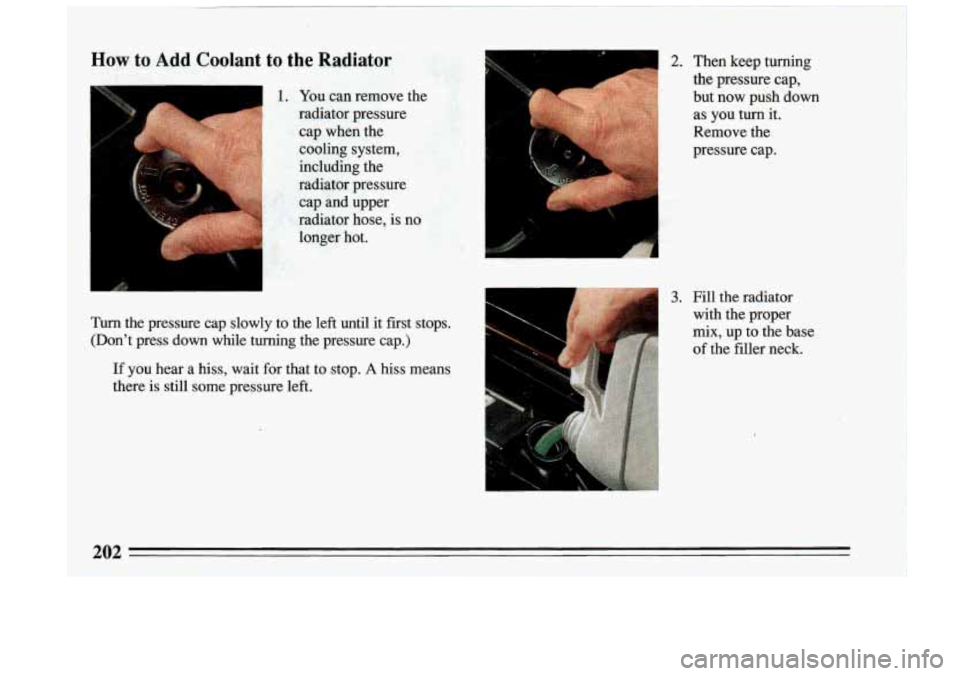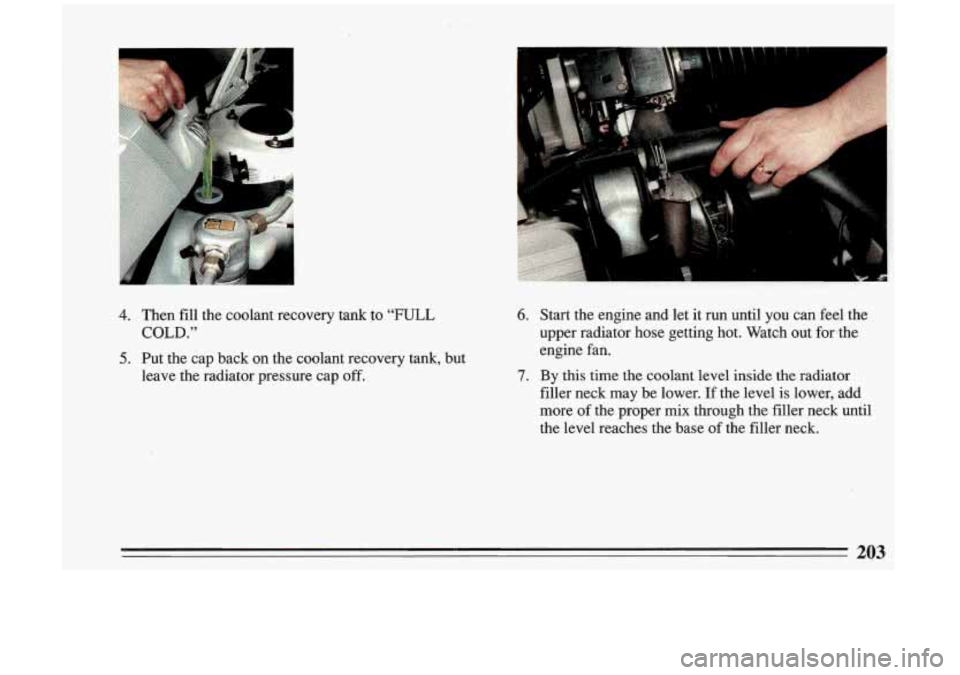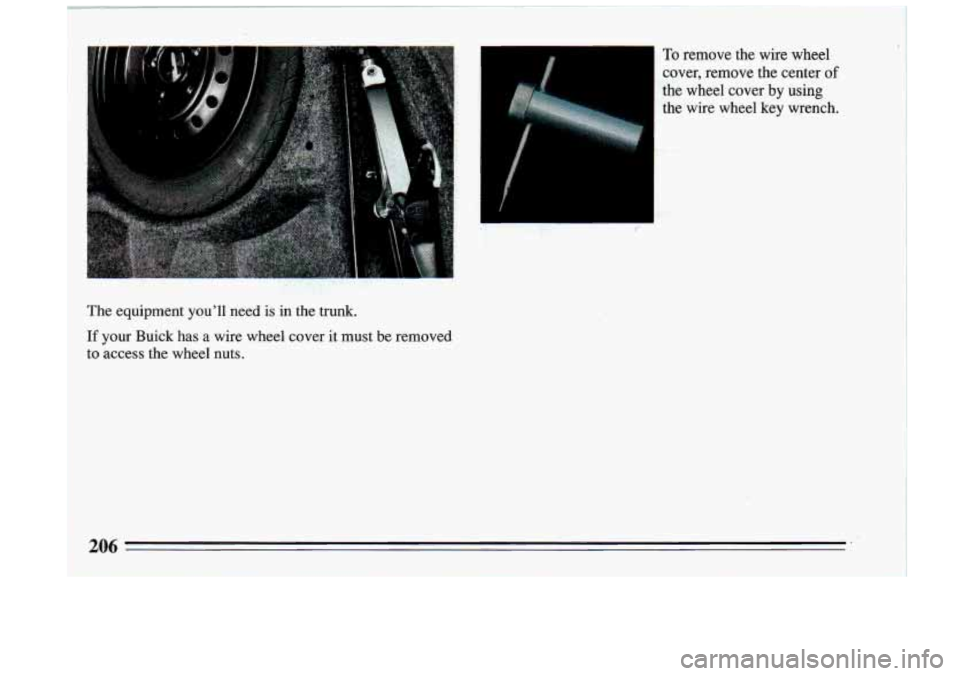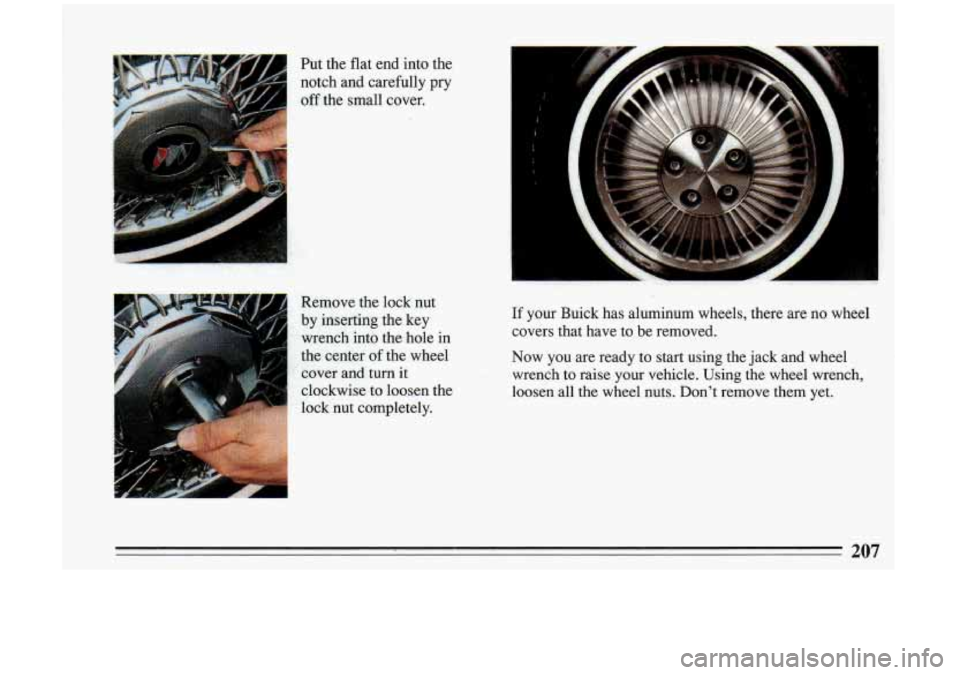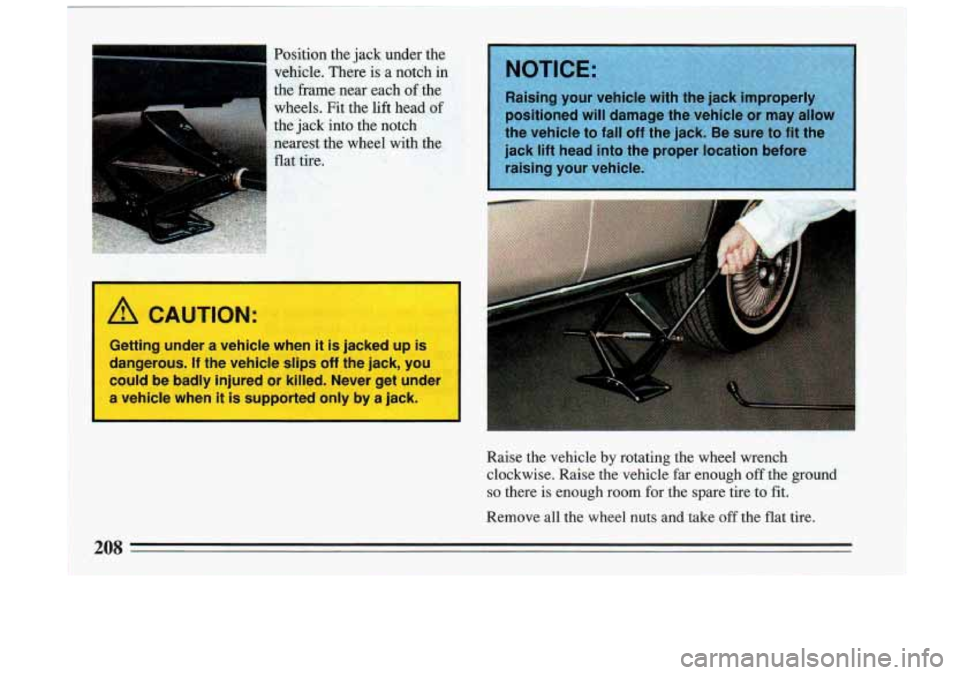BUICK RIVIERA 1993 Owners Manual
RIVIERA 1993
BUICK
BUICK
https://www.carmanualsonline.info/img/43/57701/w960_57701-0.png
BUICK RIVIERA 1993 Owners Manual
Trending: high beam, change time, manual radio set, battery replacement, lumbar support, reset, fuse
Page 201 of 324
I
A CAUTION:
' ~ Heater and radiator hoses, and other engine
--# parts, can be very hot. Don't touch them. If you I 1
.': do, you can be burned.
Don't
run the engine if there is a leak. If you run
the engine,
it could lose all coolant. That could
..~ cause an engine fire, and you could be burned.
I_ '1 Get any leak fixed before you drive the vehicle. /I
,
A CAUTION:
Adding only plain water to your cooling system
can be dangerous. Plain water, or some other
liquid like alcohol, can boil before the proper
coolant mix
will. Your vehicle's coolant warning
system
is set for the proper coolant mix. With
plain water or the wrong mix, your engine could
get too hot but you wouldn't get the overheat
warning. Your engine could catch fire and you
or others could be burned. Use a
5060 mix of
clean water and a proper antifreeze.
Page 202 of 324
I
I
CAUTION:
You can be burned if you spill coolant on hot
engine parts. Coolant contains ethylene glycol
and it will burn
if the engine parts are hot
enough. Don’t spill coolant on a hot engine.
When the coolant in the coolant recovery tank is at or
above
“FULL COLD,” start your vehicle.
If the overheat warning continues, there’s one more
thing
you can try. You can add the proper coolant mix
directly to the radiator, but be sure the cooling system is
cool before
you do it.
Page 203 of 324
A CAUTION:
Steam and scalding liquids from a hot cooling
system can blow out and burn you badly. They
are under pressure, and if you turn the radiator
pressure cap
-- even a little -- they can come out I
at high speed. Never turn the cap when the
cooling system, including the radiator pressure
cap, is hot. Wait for the cooling system and
radiator pressure cap to cool if you ever have
to
turn the pressure cap. $@.:;<;J &gjK&p
sa , Ad
Page 204 of 324
How to Ad,d Coolant to the Radiator
You can remove the
radiator pressure
cap when the
cooling system,
including the
radiator pressure cap
and upper
radiator hose, is no
longer hot.
Turn the pressure cap slowly to the left until it first stops\
.
(Don't press down while turning the pressure cap.)
If you hear a hiss, wait for that to stop. A hiss means
there is still some pressure left.
1 2. Then keep turning
the pressure cap,
but now push down as you turn it.
Remove the pressure cap.
3. Fill the radiator
with the proper
mix, up to the base
of the filler neck.
202
Page 205 of 324
1
4. Then fill the coolant recovery tank to “FULL
COLD.’3
6. Start the engine and let it run until you can feel the
upper radiator hose getting hot. Watch out forthe
-
5. Put the cap back on the coolant recovery tank, but engine fan.
filler neck may be lower. If the level is lower, add
more of the proper mix through the filler neck until
the level reaches the base of the filler neck.
leave the
radiator pressure cap
off. 7. By this time the coolant level inside the radiator
203
Page 206 of 324
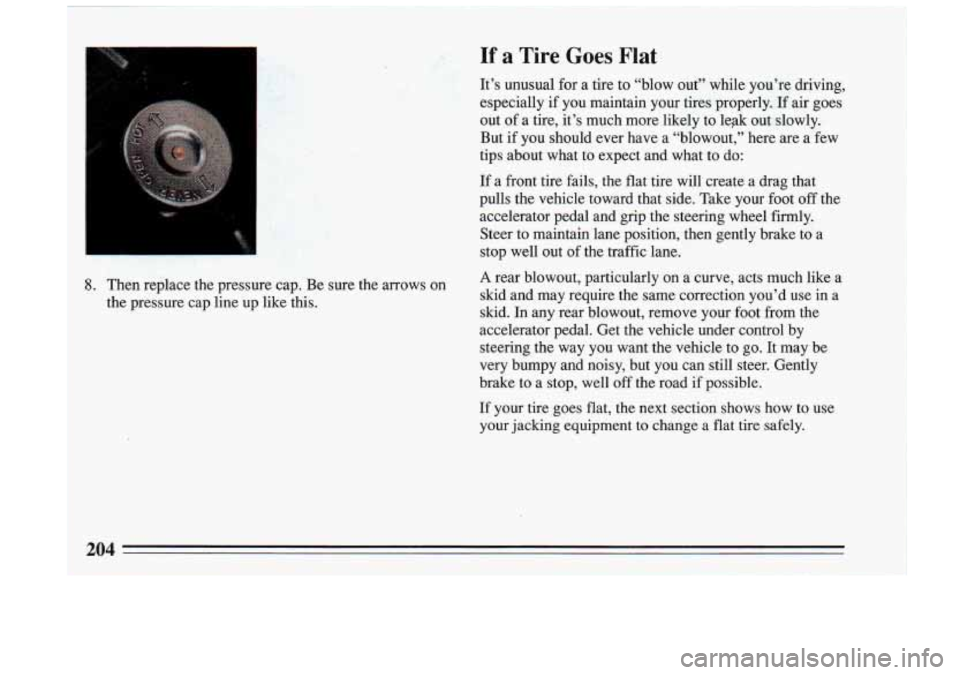
I
8.
If a Tire Goes Flat
It’s unusual for a tire to “blow out” while you’re driving,
especially if you maintain your tires properly.
If air goes
out of a tire, it’s much more likely to lepk out slowly.
But if you should ever have a “blowout,” here are a few\
tips about what to expect and what to do:
If a front tire fails, the flat tire will create a drag that
pulls the vehicle toward that side. Take your foot
off the
accelerator pedal and grip the steering wheel firmly.
Steer to maintain lane position, then gently brake to a
stop well out of the traffic lane.
Then replace the pressure cap. Be sure the arrows on
the pressure
cap line up like this.
A rear blowout, particularly on a curve, acts much like a
skid and may require the same correction you’d use in
a
skid. In any rear blowout, remove your foot from the
accelerator pedal. Get the vehicle under control by
steering the way you want the vehicle
to go. It may be
very bumpy and noisy, but you can still steer. Gently
brake to a stop, well
off the road if possible.
If your tire goes flat, the next section shows how to use
your jacking equipment to change a flat tire safely.
204
____
Page 207 of 324
91
Changing a tire can cause an injury. The vehicle
can slip off the jack and roll over you or other
people. You and they could be badly injured.
I Find a level place to change your tire. To
1. Set the parking brake firmly.
2. Put the shift lever in “P” (Park).
3. Turn off the engine.
prevent the vehicle
from moving: I
help I
I To be even more certain the vehicle won’t move,
you can put chocks at the front and rear of the
tire farthest away from the one being changed.
That would be the tire on the other side of the
I
Page 208 of 324
The equipment you'll need is in the trunk.
If your Buick has a wire wheel cover it must be removed
to access the wheel nuts.
To remove the wire wheel
cover, remove the center
of
the wheel cover by using
the wire wheel key wrench.
'
.i ,
Page 209 of 324
Put the flat end into the
notch and carefully pry off the small cover.
Remove the lock nut
by inserting the key
, wrench into the ,hole in
the: center of the wheel
‘I’ ,cover and turn it
q1ockwis.e to loosen the
lock nut completely.
i
1
i
” ,,.
If your Buick has aluminum wheels, there are no wheel
covers that have to be removed.
Now you are ready to start using the jack and wheel
wrench to raise your vehicle. Using the wheel wrench,
loosen all the wheel nuts. Don’t remove them yet.
207
Page 210 of 324
-1 Position the jack under the
3
vehicle. There is a notch in
thk frame near each of the
A CAUTION:
Getting under a vehicle when it is jacked up is
dangerous.
If the vehicle slips off the jack, you
could be badly injured
or kill,ed. Never get under
a vehicle when it
is supported only by a jack.
Raise the vehicle by rotating the wheel wrench
clockwise. Raise the vehicle far enough
off the ground
so there is enough room for the spare tire to fit.
Remove all the wheel nuts and take
off the flat tire.
20s
Trending: tire type, wheel torque, trunk release, radiator cap, service schedule, hood open, automatic transmission
